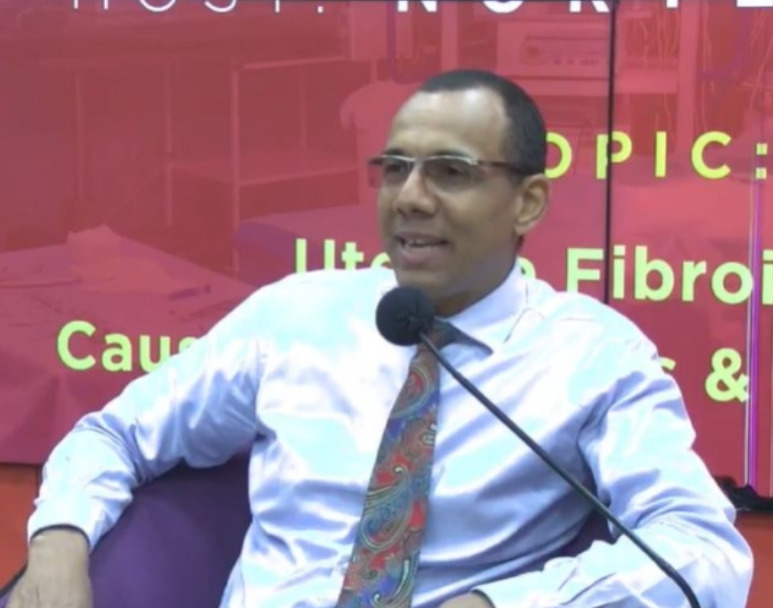
DR.michael Mccarthy, an obstetric consultant who is Gynaecologist at Sinel Specialist Hospital in Tema He emphasized the fact that having fibroids alone doesn’t make women infertile.
“Some women have fibroids but are giving birth easily,” He said.
Dr. McCarthy spoke about “Uterine Fibroids: Causes, Symptoms and Treatment” on Ultimate Health hosted by Nortey Dua on JoyFM on Sunday.
He says that the presence of fibroids does not suggest that women are naturally infertile, but it can be crucial in creating fertility issues particularly if they are found in areas where they don’t allow the endometrium develop in a proper way and may cause obstructions in particular areas and could cause frequent miscarriages or create problems when pregnant.
Explaining the definition of fibroids The doctor McCarthy explained that they’re mass of cells that develop within the uterus.
“It’s quite common but not normal condition of the uterus, where normal cells of the uterus change and start to behave the way they are not programmed to behave, growing into masses of cells,” He described further.
Gynaecologists have noted that times, fibroids are smaller in size and may be multiplying. But, the largest the doctor has taken out was a mass of 11kg of in the uterus.
According to his research that the primary causes of fibroid are genetic. There are others risk factors which could make women more vulnerable to the condition.
“As your age increases, your risk of uterine fibroids also increases to the time of menopause and the highest percentage will be women 30 years and above.”
“Even though we found out that it occurs in women in their 20s, it’s not common. So it’s normally not strange to find a woman with fibroids first presenting when she’s in her early or mid-30s,” the doctor said.
Doctor. McCarthy also stated that overweight women are at risk of developing Uterine fibroids.
Furthermore, women who’ve not had a baby tend to be at a higher likelihood of having fibroids He said, and added there are studies that suggest the fact that having children between the ages of 25-29 years may have a protective effect when it comes to getting fibroids.
A gynaecologist added fibroids tend to be an African race-related type of illness.
Doctor. McCarthy mentioned that women who were menstruating prior to age 10 may be at an increased chance of developing Uterine fibroids.
“Fibroids occur in the environment where the normal female hormones are very active. And it’s normally from puberty until menopause. That’s the big window where you see fibroids developing.”
When discussing the signs of fibroids were they are, the gynaecologist said, experiencing severe bleeding and pain often during as well as after menses. They also mentioned increased discharge, frequent urination and not with much quantity, but sometimes you feel a lump or that is moving inside your stomach or a feeling of something developing in your belly.
He said that an woman could have fibroids, and however, not be aware since there might not be any evidence that the fibroids exist.
“Remember, not all fibroids will give symptoms. In fact, only 10 per cent of people who have uterine fibroids come with symptoms.”
To avoid this that, it is always recommended for women to have gynaecological exams each year for physical examination of the uterus as well as perform an ultrasound scan so that you are secure.
Dr. McCarthy confirmed that fibroids in pregnancy may cause extreme cramping and pain in the preterm which makes it hard for the infant to align its body properly to deliver as well as be competitive with other babies for the same space.
“In fact, fibroids could also turn the uterus in a way it’s not supposed to be and could reduce blood flow to the uterus and even after delivery, they could cause excessive bleeding especially if the placenta is implanted especially where the fibroids are.”
Doctor. McCarthy explained that fibroids can’t be slowed down from growing, but when it comes time to treat both patients and doctors have to decide what they would like to accomplish.
“If it’s pain, we just treat the pain. If it’s bleeding, we treat it. If it’s anaemia, we treat the anaemia. So it depends on what’s going on, and then we can draw that treatment plan.”
He gave an example of the study was carried out in Italy which proved that exercising can aid in uterine fibroids treatment and prevention.
“Those who did 7 hours exercise a week or more had slower growing fibroids as compared to those who did 2 hours or less exercise a week.”
The speaker, in turn, suggested all to pay attention to the choices they make in their lives and to eat healthy (less sugar, salt or alcohol) as well as engage in more exercise to promote healthy progress.
